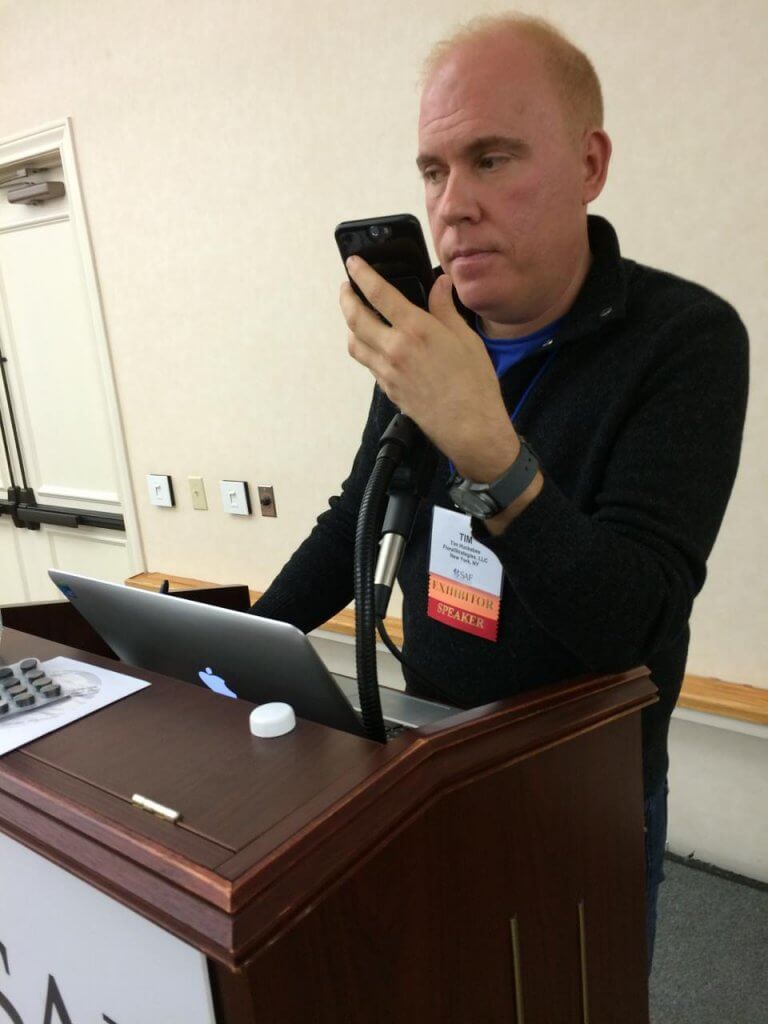Floral Strategies celebrates its 20th anniversary next month. After 5,000 shop visits over three continents, dozens of webinars and magazine articles, and too many presentations to count, founder Tim Huckabee, AIFSE, looks back on where the journey began—and his vision for the future.

F20: Take us back in 20 years. How did Floral Strategies begin?
TH: We really need to go back 24 years. I’d just moved to New York City with a degree in marketing from the University of Connecticut. I was reading newspaper ads, calling companies, and going on interviews. But we were in a recession and I really didn’t have any hot prospects. After a month of looking, I decided I needed to get a part-time job to make some money while I hunted for my marketing job.
F20: So you stumbled on an ad for a flower shop?
TH: I did, at Surroundings. It was for customer service and sales, which I smugly thought any fool could do. I met the owner. We clicked and I got the job.
F20: Was it as easy as you imagined?
TH: Ha! I started on April 23—two weeks before Mother’s Day. I asked my coworkers what the holiday was like and they gave me looks that suggested I had no idea what I was in for. I was petrified, sure I was going to be talking to super educated, affluent people spouting off Latin flower names at me. It was definitely a baptism by fire, but not as scary as what I’d built up in my head those first two weeks. What I found was that people just wanted beautiful designs and someone who could describe what it would look like.
F20: You obviously got the flower bug. What was it about that job that you loved?
TH: Surroundings was very well organized and efficient. Sales people went through basic design training so we could help out in a pinch, but also so we’d be better at describing an arrangement. As I’ve said to clients over and over again, the more descriptive you are, the easier it is to upsell. You’re never going to get someone to pay $100 for something that looks “nice.”
F20: What spurred you to move on?
TH: I’d been there four years and just had my eyes on something bigger. One of my jobs was calling out orders to florists in other cities. In those conversations, I quickly realized there were things Surroundings was doing really well that others were not. It wasn’t that we were a fancy New York City shop—it was that we were organized when taking orders, which minimizes mistakes, and we weren’t scared when talking with customers.
So I packaged some of the shop’s lessons into a training program. I scored a lunch meeting with Ted Winston in Boston and told him about my vision. We tested it out in his shop (Winston’s) for three or four days and it worked so well, he asked me to do it again. He also did me an enormous favor and talked me up to his friends in the industry. He’s so well connected, that his phone calls gave me my big break. I really didn’t start advertising until about 2012!
F20: What was your original model?
TH: I wanted to bring sales and customer service training to the florists. I felt this was lacking in the industry. Not every shop can afford to send a team to business seminars—and many worry about how their staff is performing while they’re gone. By training florists in their own shops, they can operate as usual and every employee gets educated, not just owners and managers.
This is still the main thing that we do. We divide the staff in two, training the first half in the morning and the others in the afternoon. We teach them to be better listeners, which is key to becoming a good sales person. They learn cues to listen for and how to communicate to customers what choices they have. They drop the bad habits—“How much do you want to spend?” and “Our designs start at $29…”—and figure out what the customers want and how they can wow them. They have bravado and are confident sharing their expertise.
I’ve trained people from age 13 to 92. I go wherever the client wants. We’ve trained in basements, attics, owners’ living rooms, coffee shops, etc.
F20: How has Floral Strategies grown over the years?
TH: Perhaps the biggest addition has been our webinar series, which we started in 2011. As the Internet became more and more ubiquitous, it seemed obvious that we could reach a lot more florists online. There are only so many days a year I can travel! The webinars echo what I teach in person and are a cheaper alternative to a shop visit. We’ve had webinar participants from six continents, which is really satisfying to know. We do about one session every six to eight weeks.
F20: How do you come up with fresh content to keep the webinars going?
TH: We solicit feedback for participants, for starters. I also spend a few weeks a year in various shops taking orders. This helps me keep my finger on how customers’ shopping habits are evolving and challenges that florists face. When I come across florists with specialized expertise, like visual merchandising, prom work or funeral sales, I’ll approach them about hosting a webinar with me.
F20: What are your plans for the future?
TH: I’m solidifying details for a sales accreditation program. It will be online, like the University of Phoenix, and will include courses and tests. This will make them immensely more valuable to their shops and will stand out to prospective employers if they choose to change jobs. Owners will know a candidate doesn’t have the typical bad habits, knows how to use the POS system to make better sales, and doesn’t fear customers.
Ultimately, I’d like to see more respect for the business side of the industry. I feel like there’s a disproportionate emphasis on design. I know people who would sell plasma to afford a trip to AIFD symposium, but they wouldn’t consider investing in sales training. If you don’t have good sales people, no one’s going to buy those fantastic AIFD-quality designs—because they don’t cost $29! Sales people, customer service reps and delivery drivers are just as important as designers.

